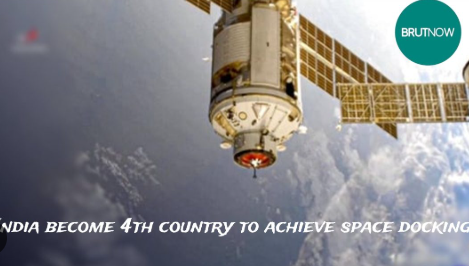India Achieves Historic Milestone with Successful Spacecraft Docking Mission
Introduction
India has taken a giant leap in space exploration by successfully accomplishing its first-ever space docking mission. This historic achievement not only marks a technological breakthrough but also paves the way for future ambitious projects, including space stations and deep-space exploration. The successful docking highlights India’s growing prowess in space technology and reinforces its commitment to becoming a major player in the global space industry.
What is Space Docking?
Space docking is a complex maneuver where two spacecraft come together in orbit and connect safely. This process is crucial for many space missions, including crewed space stations, in-orbit refueling, and assembling modular spacecraft for deep-space missions. The ability to dock successfully ensures long-term sustainability for human spaceflight and interplanetary travel. India’s success in this domain is a testament to its advancing space capabilities.
India’s Journey to Space Docking
India’s journey toward mastering space docking has been long and meticulous. The Indian Space Research Organisation (ISRO) has been making significant strides in space technology, from launching satellites to interplanetary missions like Chandrayaan and Mangalyaan. The space docking mission required rigorous planning, advanced automation, and precision engineering. The success of this mission showcases ISRO’s technical expertise and readiness for more complex space endeavors.
The Technology Behind the Docking Mission
The space docking mission involved cutting-edge technology, including autonomous navigation, precision thrusters, and real-time communication. The spacecraft used high-resolution cameras and sensors to align and connect accurately. The docking mechanism included latching mechanisms and shock absorbers to ensure a smooth and secure connection. AI-driven algorithms played a crucial role in guiding the spacecraft without human intervention, ensuring efficiency and accuracy.
Strategic Importance of the Mission
The successful space docking mission is of immense strategic importance for India. It lays the foundation for the country’s ambitious plans to build its own space station in the coming decade. With a self-sustained space station, India will be able to conduct long-duration space research, enable human spaceflights, and facilitate international collaborations. Additionally, this mission strengthens India’s position in the competitive global space sector.
Implications for Future Space Missions
With this technological milestone, India is now equipped to undertake more advanced space missions. Space docking is a critical component of sustainable human spaceflight, interplanetary missions, and space tourism. India’s ability to dock spacecraft opens doors for potential international partnerships, joint missions, and commercial opportunities in space exploration. The success of this mission also boosts India’s ambitions to send humans to space under the Gaganyaan mission.
Global Recognition and Comparisons
India’s success in space docking places it among an elite group of space-faring nations such as the United States, Russia, and China, which have already mastered this technology. The achievement has been widely recognized by the global scientific community and space agencies. By developing indigenous capabilities, India demonstrates its self-reliance and innovation in space technology.
Challenges and Overcoming Obstacles
Executing a space docking mission is a highly challenging task that requires precise calculations, advanced technology, and seamless execution. Some of the major challenges include:
- Orbital Alignment: Ensuring both spacecraft are aligned correctly in orbit.
- Autonomous Navigation: Using AI and machine learning for real-time adjustments.
- Structural Integrity: Designing docking mechanisms that can withstand the harsh environment of space. Despite these hurdles, ISRO’s successful docking mission proves its ability to overcome obstacles with innovation and determination.
Future Prospects and Vision
India’s success in space docking aligns with its long-term space vision, which includes:
- Developing a Permanent Space Station: By 2035, India aims to have an operational space station for long-term research.
- Lunar and Martian Missions: Docking technology will play a crucial role in future missions to the Moon and Mars.
- International Collaborations: The ability to dock spacecraft makes India a valuable partner for global space missions.
- Commercial Space Exploration: India can now explore opportunities in satellite servicing, space tourism, and private-sector collaborations.
Conclusion
India’s successful space docking mission is a defining moment in its space exploration journey. This achievement not only reinforces its technical capabilities but also sets the stage for ambitious future missions. With advancements in space docking technology, India is poised to become a major player in global space exploration. The mission underscores ISRO’s commitment to innovation, self-reliance, and its goal of making India a leader in space science and technology.


Leave a Comment